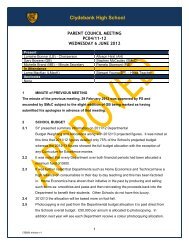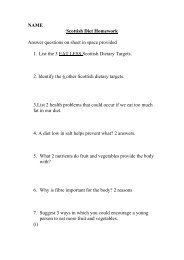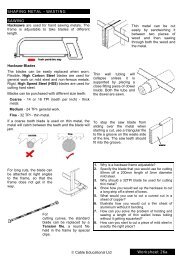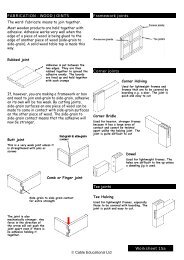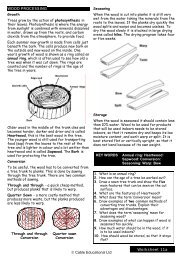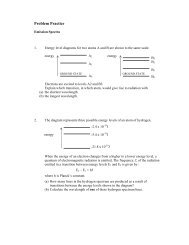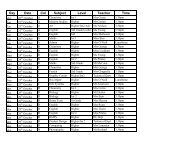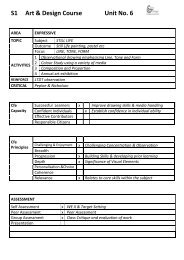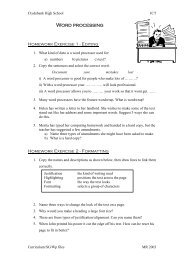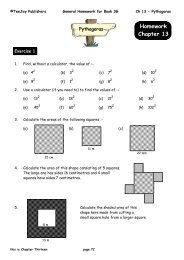Paper 4 - Clydebank High School
Paper 4 - Clydebank High School
Paper 4 - Clydebank High School
You also want an ePaper? Increase the reach of your titles
YUMPU automatically turns print PDFs into web optimized ePapers that Google loves.
12345678<br />
12345678<br />
12345678<br />
12345678<br />
12345678<br />
12345678<br />
12345678<br />
12345678<br />
12345678<br />
12345678<br />
12345678<br />
12345678<br />
12345678<br />
12345678<br />
12345678<br />
12345678<br />
12345678<br />
12345678<br />
12345678<br />
12345678<br />
12345678<br />
12345678<br />
12345678<br />
12345678<br />
1. The diagrams below show three different cells, not drawn to scale.<br />
G<br />
Marks<br />
DO NOT<br />
WRITE IN<br />
THIS<br />
MARGIN<br />
KU<br />
PS<br />
(a)<br />
Select information from the diagrams above to copy and complete the<br />
table below.<br />
The information on the onion cell has been completed for you.<br />
2<br />
(b) Name two features which are found only in plant cells.<br />
1___________________________________<br />
2___________________________________<br />
1<br />
(c)<br />
Describe how cells can be treated so that the cell contents become more<br />
visible.<br />
1<br />
[SGB/HW/CELLS]<br />
page 1
12345678<br />
12345678<br />
12345678<br />
12345678<br />
12345678<br />
12345678<br />
12345678<br />
12345678<br />
1. (Continued)<br />
G<br />
Marks<br />
DO NOT<br />
WRITE IN<br />
THIS<br />
MARGIN<br />
KU<br />
PS<br />
(d)<br />
The diagram shows some plant cells as they appear when viewed under a<br />
microscope.<br />
Calculate the average length of the cells.<br />
Show your working.<br />
1<br />
[SGB/HW/CELLS]<br />
page 2
123456789<br />
123456789<br />
123456789<br />
123456789<br />
123456789<br />
123456789<br />
123456789<br />
123456789<br />
123456789<br />
123456789<br />
123456789<br />
123456789<br />
123456789<br />
123456789<br />
123456789<br />
123456789<br />
12345678<br />
12345678<br />
12345678<br />
12345678<br />
12345678<br />
12345678<br />
12345678<br />
12345678<br />
2. (a) Copy and complete the table by using all the letters from the list to<br />
identify the parts found in each type of cell.<br />
Each part may be used once or more than once.<br />
Parts of cells<br />
A cell membrane<br />
B cell wall<br />
C chloroplast<br />
D cytoplasm<br />
E nucleus<br />
G<br />
Marks<br />
DO NOT<br />
WRITE IN<br />
THIS<br />
MARGIN<br />
KU<br />
PS<br />
2<br />
(b)<br />
Use the information in the table below to answer the questions about<br />
liquids used in preparing microscope slides.<br />
(i)<br />
Name two liquids used to prepare plant cells.<br />
1<br />
2<br />
1<br />
(ii)<br />
What effect does eosin have on skin cells?<br />
1<br />
[SGB/HW/CELLS]<br />
page 3
123456789<br />
123456789<br />
123456789<br />
123456789<br />
123456789<br />
123456789<br />
123456789<br />
123456789<br />
123456789<br />
123456789<br />
123456789<br />
123456789<br />
123456789<br />
123456789<br />
123456789<br />
123456789<br />
12345678<br />
12345678<br />
12345678<br />
12345678<br />
12345678<br />
12345678<br />
12345678<br />
12345678<br />
2. (Continued)<br />
G<br />
Marks<br />
DO NOT<br />
WRITE IN<br />
THIS<br />
MARGIN<br />
KU<br />
PS<br />
(c)<br />
What name is given to a liquid that is used to make the parts of a cell<br />
clearer when viewed under a microscope?<br />
1<br />
(d)<br />
The magnification of a microscope is calculated using the following<br />
formula.<br />
Total magnification = eyepiece lens x objective lens<br />
magnification magnification<br />
Use the formula to copy and complete the following table. The<br />
same eyepiece was used each time.<br />
2<br />
(e)<br />
The diagram below shows some human cheek cells as they appear<br />
when viewed through a microscope.<br />
The diameter of the field of view of the microscope is 120<br />
micrometres.<br />
Calculate the average width of a human cheek cell.<br />
Show your working.<br />
1<br />
[SGB/HW/CELLS]<br />
page 4
123456789<br />
123456789<br />
123456789<br />
123456789<br />
123456789<br />
123456789<br />
123456789<br />
123456789<br />
123456789<br />
123456789<br />
123456789<br />
123456789<br />
123456789<br />
123456789<br />
123456789<br />
123456789<br />
123456789<br />
123456789<br />
123456789<br />
123456789<br />
123456789<br />
123456789<br />
123456789<br />
123456789<br />
12345678<br />
12345678<br />
12345678<br />
12345678<br />
12345678<br />
12345678<br />
12345678<br />
12345678<br />
12345678<br />
12345678<br />
12345678<br />
12345678<br />
12345678<br />
12345678<br />
12345678<br />
12345678<br />
3. (a) The diagram below represents a plant cell as seen under a<br />
microscope.<br />
G<br />
Marks<br />
DO NOT<br />
WRITE IN<br />
THIS<br />
MARGIN<br />
KU<br />
PS<br />
(A)<br />
(B)<br />
(i) Give the name of the structures labelled (A) and (B).<br />
2<br />
(ii)<br />
What is the function of the nucleus?<br />
1<br />
(iii) From the diagram, select one piece of evidence to confirm that<br />
this is a plant cell.<br />
1<br />
(b)<br />
The diagrams below show some human cheek cells as they<br />
appeared under a microscope, at two different magnifications.<br />
Describe the effect that increasing the magnification had on<br />
(i) the apparent size of the cells<br />
1<br />
(ii) the area of the slide seen.<br />
1<br />
[SGB/HW/CELLS]<br />
page 5
12345678<br />
12345678<br />
12345678<br />
12345678<br />
12345678<br />
12345678<br />
12345678<br />
12345678<br />
12345678<br />
12345678<br />
12345678<br />
12345678<br />
12345678<br />
12345678<br />
12345678<br />
12345678<br />
4. (a) Copy the following sentence choosing one word in each set of<br />
brackets to make the sentences correct.<br />
{<br />
Cells<br />
}<br />
Tissues are the basic units of living organisms.<br />
Organs<br />
G<br />
Marks<br />
DO NOT<br />
WRITE IN<br />
THIS<br />
MARGIN<br />
KU<br />
PS<br />
Most of them are too small to be seen with the naked eye and are<br />
almost transparent. A microscope magnifies them so that we can see<br />
them, and coloured chemicals called<br />
{<br />
indicators<br />
}<br />
stains can be added to make certain parts easier to see.<br />
pigments<br />
1<br />
(b)<br />
The following are drawings of cells. They are not drawn to the<br />
same scale.<br />
Give the letters of all animal cells.<br />
1<br />
[SGB/HW/CELLS]<br />
page 6
123456789<br />
123456789<br />
123456789<br />
123456789<br />
123456789<br />
123456789<br />
123456789<br />
123456789<br />
123456789<br />
123456789<br />
123456789<br />
123456789<br />
123456789<br />
123456789<br />
123456789<br />
123456789<br />
123456789<br />
123456789<br />
123456789<br />
123456789<br />
123456789<br />
123456789<br />
123456789<br />
123456789<br />
123456789<br />
123456789<br />
123456789<br />
123456789<br />
123456789<br />
123456789<br />
123456789<br />
123456789<br />
5. Use the information in the table below to answer the following questions<br />
about the simple aquatic organisms. Each organism consists of a single<br />
cell.<br />
G<br />
Marks<br />
DO NOT<br />
WRITE IN<br />
THIS<br />
MARGIN<br />
KU<br />
PS<br />
(a)<br />
Which organism has the smallest cells?<br />
1<br />
(b)<br />
Which organism does not contain food vacuoles?<br />
(c)<br />
Which organism moves using cilla?<br />
1<br />
1<br />
(d) Euglena carries out photosynthesis. Describe one way in which<br />
euglena differs from typical green plant cells?<br />
1<br />
[SGB/HW/CELLS]<br />
.<br />
page 7
12345678<br />
12345678<br />
12345678<br />
12345678<br />
12345678<br />
12345678<br />
12345678<br />
12345678<br />
12345678<br />
12345678<br />
12345678<br />
12345678<br />
12345678<br />
12345678<br />
12345678<br />
12345678<br />
12345678<br />
12345678<br />
12345678<br />
12345678<br />
12345678<br />
12345678<br />
12345678<br />
12345678<br />
G<br />
6. (a) Diagrams of two cells from different organisms are shown below.<br />
Marks<br />
DO NOT<br />
WRITE IN<br />
THIS<br />
MARGIN<br />
KU<br />
PS<br />
Cell 1 Cell 2<br />
(i)<br />
Copy and complete the table to give both the name and the<br />
function of each of the parts labelled A, B and C.<br />
Choose answers from the lists below.<br />
List of names<br />
cell membrane<br />
cell wall<br />
nucleus<br />
chloroplast<br />
vacuole<br />
List of functions<br />
provides rigid support for cell<br />
respiration<br />
photosynthesis<br />
controls entry and exit of materials<br />
controls all cell activities<br />
(ii)<br />
Is cell 2 a plant or animal cell?<br />
Give one reason for your answer.<br />
3<br />
1<br />
(b) Copy and complete the following sentence by filling in the blank.<br />
A group of cells working together and performing the same function<br />
is known as a _______________.<br />
1<br />
[SGB/HW/CELLS]<br />
page 8




